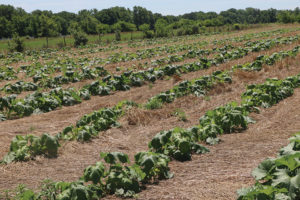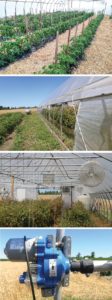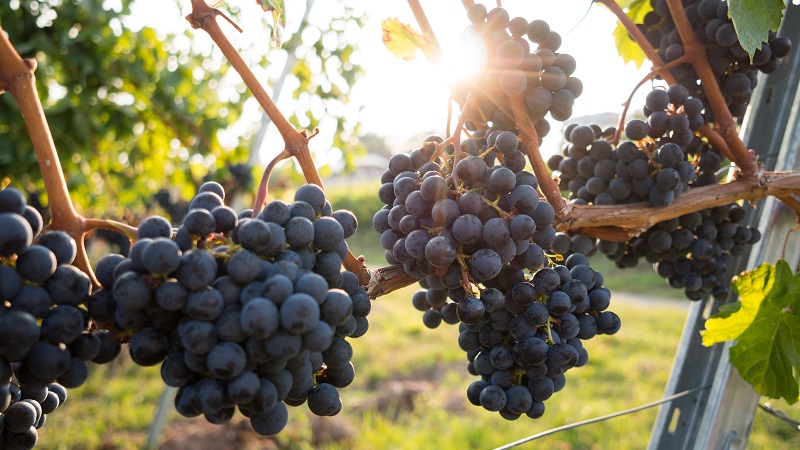His Farm Is His Research Lab

Tye Thompson
Tye Thompson isn’t the usual grower national trade magazines visit and interview. For starters, he’s young — still a college student. Most growers are more than 55 years old — 68%, according to our most recent State of the Vegetable Industry Survey.
And his farm? Just 15 acres, located in Dundee, MI. But consider this: He started with a 120 foot x 70 foot plot when he was a high school freshman, back in 2012. He’s gained those 15 acres from his own hard work.
Thompson has a rare advantage. He’s learning new growing techniques from some of the best in the industry — Michigan State University (MSU) researchers and professors. And since he’s his own boss, he doesn’t have to get approval to try out those techniques.
The resulting farm is a surprisingly sophisticated growing operation. It’s not often you see plasticulture on such a small scale. And the small, 2,160 square-foot greenhouse is set up for fertigation, climate control, and air circulation.
“I am still trying to figure out what works best for me, and I always like to try new things and improve what I have done in the past,” Thompson says. “I have learned that some methods work good for some crops and not others.”
Sophisticated techniques usually mean higher costs. Conventional wisdom is that only large growers can afford them, since they have the advantage of economies of scale. But Thompson begs to differ.
“Overall, I would say it pays off,” he says. “I have learned a lot this year and hope that I will be able to produce more next year and be a little more profitable.”
If a college student is making a profit on 15 acres, you may want to adopt some of his growing techniques for yourself. Here’s a sampling of his production methods you may want to try.
Strip Till with Cover Crops

Cover crops suppress weeds and keep soil moist.
MSU researchers have done extensive work on how effective cover crops are for suppressing weeds, keeping moisture in, and the crops clean. Thompson was understandably eager to use the methods on his farm. He started with a cover crop and no tilling.
“The first time I tried to plant pumpkins into killed winter rye it worked good. But it needed some improvements,” he says.
One issue was breaking through the rye to plant his pumpkin seeds. And when he did get the seeds in the ground, they didn’t necessarily stay there.
“Depending on how the seeds are planted, it is hard to get the seeds deep enough so the birds don’t find the seed and eat it.”
He also had problems with the pumpkins germinating.
“The ground is so hard, it can take up to two weeks for the pumpkin seeds to germinate and pop up through the ground,” he says.

Tilling a narrow furrow allows seeds to be planted at the proper depth.
So he began strip tilling, where the cover crop is left in place, but a narrow furrow is tilled for the seed line. It’s just wide enough for proper planting.
“It makes a nice seed bed for the pumpkin seeds. They can germinate quickly, and I have little problems with the birds,” Thompson says.
Trialing Cover Crop Methods
Thompson has always used rye as a cover crop, but after a few classes, he started experimenting with other cover crops.
Oats and radish. He plants these cover crops after planting sweet corn.
“They work great,” he says. “They die in the winter so I don’t have to deal with any living plant material in the spring when I am trying to lay plastic and transplant very early.”
Barley. Thompson is still evaluating how well barley works. He planted it between the rows where he used plastic. He then killed it with a grass herbicide once it reached 5 inches tall.
“I wanted to try this to keep things cleaner when it rains — not just the fruit, but your boots, as well, when picking after it has rained,” he says.
But he found that method too costly, both in terms of cash and time.
“The cover crop accomplished what I wanted it to do for the most part, but I need to try more ideas and methods before I plant cover crops between all rows of plastic,” he says.
A Tricked-Out Greenhouse

Despite its small size, Thompson’s greenhouse has a fertigation tank and lines, air circulation, and venting.
Thompson did a great deal of his experimenting in his 30 foot x 72 foot greenhouse, where he grows mostly tomatoes and some cucumber. He was pleased with the results.
Here’s what he has to say about how his system works.
Structure. “I had a company called Nifty Hoops (NiftyHoops.com) help me with this greenhouse,” he says. “I liked that they had greenhouse options with louver vents on the end walls for winter and early spring. And I liked the fact that there are roll-up side curtains.
“Both these vents make a great way to cool the greenhouse when it’s cooler outside, as well as very hot.”
Air circulation. “I installed all the electrical components of the greenhouse [heater, fans, thermostats, irrigation, and a light],” Thompson says. “The fans are mainly for air circulation, and I placed the heater high so the heat did not get put right on the plants. I have four fans, basically one in each corner so the air gets circulated around the greenhouse. The fans help greatly with heat distribution, and air movement for disease control,” he says.
Electricity. “Why is it electrified? So I can have heat, irrigation, and fans for circulation,” he says.
Irrigation and fertigation. “Because I do not have a well or pond, I have to haul water for the greenhouse,” he says. “I have a 500-gallon tank in the greenhouse, so the water stays warm in the early spring. I simply add fertilizer to the tank of water as needed. I irrigate with drip tape,” he says.
“I have been using a little bit of drip irrigation in my greenhouse as well as in some crops in the field under plastic mulch. I learned a lot about drip and all other irrigation practices from a great irrigation course that MSU offers taught by Marcus Duck [Advisor and Instructor at MSU and Institute of Agricultural Technology Program Coordinator].”
Pests and diseases. “I don’t have very many weeds in the greenhouse as I use a lot of mulch to cover the ground. And any weeds that do come through, I simply chop up with an electric weed whacker,” Thompson says. “Because of the drip irrigation and great circulation, I do not have to spray fungicide much at all.”
Heating and cooling. “I have a vented propane heater, and cooling is just done through the side vents and louvers,” he says.
Growers Still the Best Teachers
“I would like to mention … even though school has taught me a lot, I have probably learned the most from watching and talking with other farmers,” Thompson says. “Over the past few years, I try to talk to and watch farmers that I want to be as successful as to see how they do things and learn as much as possible from them. Just doing this has taught me so much and has given me great opportunities.”
What Does the Future Hold?
Thompson admits he has a lot on his to-do list, but irrigation is at the top. Many Midwest and Northeast operations have enough rainfall through the year; they don’t irrigate their crops.
If he has his way, Thompson will soon buck the norm.
“I have not irrigated in the past because I have not had a source for it — a pond or well — but as soon as I do have a water source, you can bet that I will be irrigating,” he says. “I have learned this year — we had drought-like conditions — that it’s almost not worth growing the vegetables without irrigation. There’s too much demand waiting for them (daily customers) and too much money put into them not to be able to harvest anything.”
Another ambition Thompson has after graduation is to consolidate his farm stands. He currently has three trailers set up in his community that operate on the honor system. He’d like to have a permanent farm market.
“Not only would I like to sell the produce at the store, but I would also like to sell other items such as meat, canned as well as frozen foods (from my crops),” he says.
He also has ambitions to grow and sell ornamental crops, both floral and decorative vegetables like pumpkins.
“There are also things that I would like to do during the winter months as well to continue income, such as Christmas trees and food items for Thanksgiving such as fresh turkey, winter squash, and pies,” he says.
Any experienced grower will recognize he has a lot of hard work in his future. It’s a good thing he’s more than up to the task.










